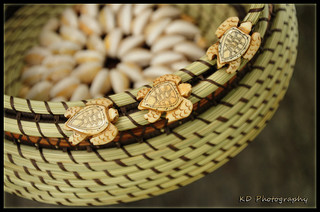Pine Needle Art
 Pine needle art is an outgrowth of an ancient material culture tradition in North Carolina. For several millennia, the Native Americans living in the region that became North Carolina fashioned utilitarian and decorative objects from the trees and plants surrounding them. The abundance of pine trees in the region led to the use of pine needles to make baskets and other objects. Pine needle objects made with coiled techniques have European, African, and Native American origins.
Pine needle art is an outgrowth of an ancient material culture tradition in North Carolina. For several millennia, the Native Americans living in the region that became North Carolina fashioned utilitarian and decorative objects from the trees and plants surrounding them. The abundance of pine trees in the region led to the use of pine needles to make baskets and other objects. Pine needle objects made with coiled techniques have European, African, and Native American origins.
Pine needle art uses the leaf of the pine tree. After boiling, drying, and removing the caps from the pine needles, the artist bundles together the needles. Coiling them in tight spirals, the artist builds each new row upon the preceding one, and binds the rows together with strong raffia, nylon, or rayon threads. The artist often adds a coating of shellac or clear acrylic to protect the finished object.
Pine needle art includes a variety of utilitarian and decorative forms and functions. These include trays, baskets, bowls, coasters, mats, and wall hangings.
References:
Judy Mofield Mallow, Pine Needle and Nut Crafting, vol. 1 (1984).
Linda L. Millikin, Pine Needle Baskets (1920).
Veronica T. Walsh, The Book of Pine Needle Craft (1977).
Image Credit:
"Pine Needle Shell & Turtle Basket." Image courtesy of Flickr user K. Oliver-Dykes. Available from https://www.flickr.com/photos/ksd-photography/4912030944/ (accessed May 24, 2012).
1 January 2006 | Cross, Dennis W.